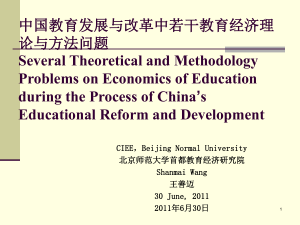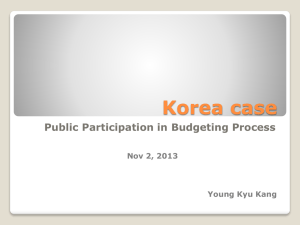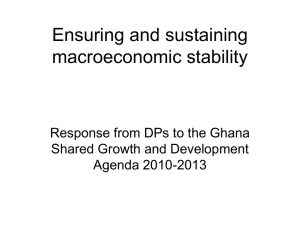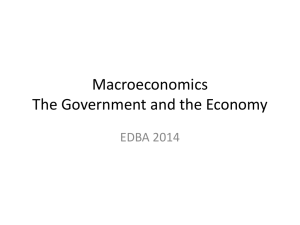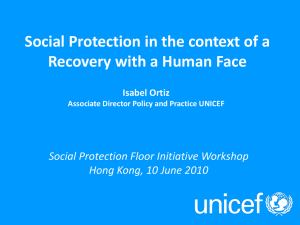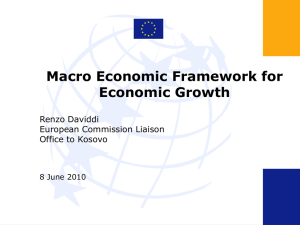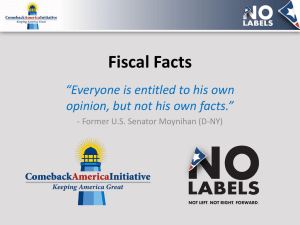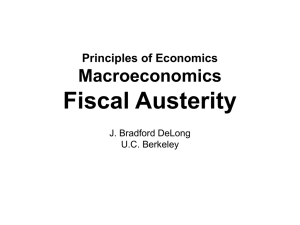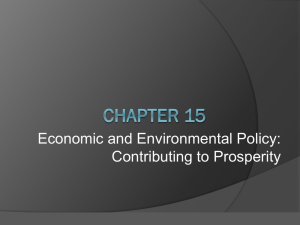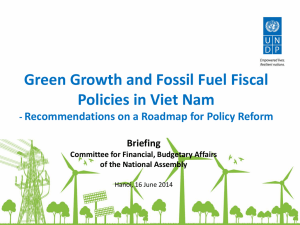Benjamin Jones` Your Lecture presentation
advertisement
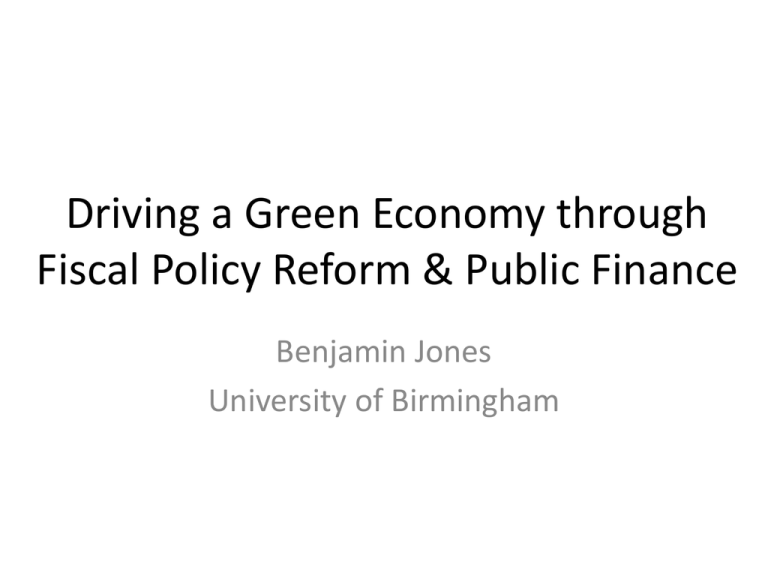
Driving a Green Economy through Fiscal Policy Reform & Public Finance Benjamin Jones University of Birmingham Outline • • • • • Introduction & framework issues Role of fiscal policies Green taxes & charges Expenditure & subsidy reform Conclusions Introduction • The debate on environmental sustainability and appropriate policy responses takes place amidst efforts to recover from the crisis and address fiscal challenges ahead. • How should these challenges influence environmental policy? How should sustainability issues be reflected in macro fiscal policies over the short and particularly longer terms? • “Driving a Green Economy through Fiscal Policy and Public Finance”, Journal of International Economics, Commerce and Policy, 2011 Why a green economy? • Evidence on the economic consequences of environmental sustainability issues have been growing across both industrialized and developing countries in recent years. – Declining fish stocks – 25% of marine stocks “collapsed” – Land pressures from rising population – Global challenge of climate change – costs equivalent to 5-20% GDP • At the same time, the economic crisis has generated heightened demand for new sources of sustainable growth and job creation. • Green Economy is an emerging concept linking economic growth and environmental sustainability. It focuses on economic opportunities, including from: – New green technologies and sectors – More efficient resource use – Reversal of environmentally harmful policy distortions, eg energy subsidies – Avoid sustainability related growth impediments Some policy evaluation issues • The economic case for environmental measures is typically complex to evaluate, and often only weakly understood by policy makers: – Non market valuations – Overlapping policy instruments, unobservable baselines – Intertemporal mismatch between costs & benefits • Understanding the distributional implications are critical to managing an equitable transition, but, once again, are difficult to appraise: – – – – Consumption patterns vary across households Time frame for evaluation? Indirect effects on wages, asset prices Distribution of environmental benefits? • Indicators desirable to help measure key interactions between the environment and economy and guide policy management: – Investment, employment & output in key sectors – “Green” National accounting A central role for fiscal policies • Fiscal policies are key to robust, fair & sustainable economic growth • Taxes and charges aimed at “getting the prices right” – necessary (but not sufficient) to encourage less pollution/ resource intensive economy. • Sound revenue potential, and a relatively efficient base: environmental taxes raise around 2 percent GDP on average across OECD countries. Huge international revenue potential from carbon pricing! • Targeted expenditure measures can harness private “green” investment (e.g. significant environmental consequences from infrastructure projects); & protect the incomes of the most vulnerable from higher prices. • But spending policies should not substitute for more efficient pricing of pollution — especially given the intense fiscal challenges many countries now face. • Careful consideration of interactions between environmental and wider fiscal and regulatory policies important: e.g. income taxes/ renewable energy subsidies. Environmental taxes and charges • Taxes bearing on environmental sustainability include: – – – – Environmentally damaging products (e.g. fossil fuel excise) Natural resource extraction (e.g. royalties on minerals, oil & gas) Harmful by-products of consumption/ production (e.g SOx/NOx charges) User charges on basic services (e.g. electricity, water and sanitation) • Concrete policy evaluations remain scarce: energy tax reforms in EU countries (e.g. Germany, Denmark & Sweden) during the 1990’s estimated to have reduced GHG emissions by around 2-6 percent. • Despite this, it is clear that many reforms have been weakened by exemptions and rate reductions, motivated by concerns over the competitiveness of trade exposed industries. • The economic effects of such levies depend on how revenues are used: Germany recycled energy excise revenues to reduce income and social security payments amounting to 3% GDP 1996-99 • Widespread earmarking of environmental tax revenues observed in both developed & developing countries Some key tax reform priorities • More rational taxation of fossil fuels – Removal of excise exemptions (e.g. to coal) – Systemizing rates reflecting environmental and social harm (e.g. limit preferential treatment of diesel). – Reforming VAT arrangements where relevant. – More fundamental excise restructuring? Congestion charging / road pricing. • Strengthen international carbon markets – – – – More robust and stable prices (tighter constraints, expanded coverage) Incentives to limit tropical deforestation International aviation and shipping Mobilize revenue opportunities e.g. through auctioning permits • Improved cooperation on international tax competition. – Minimum rates? • Robust and stable fiscal frameworks to capture natural resources rents • Investment in tax administration critical to successful environmental fiscal reform, particularly in developing countries. ‘Green’ fiscal Stimulus • Environmental measures formed a valuable part of fiscal stimulus packages: $430 billion (roughly 15%) of stimulus expenditure of 20 countries allocated to climate-related investment themes. • But much stimulus spending is on “dirty” investments (e.g. $270 billion allocated to road building projects in the G-20) — risked entrenching inefficiencies from the under-pricing of emissions. • No rigourous ex post analysis on employment effects from environmental stimulus programmes undertaken. Ex ante preference for measures which reduce, rather than raise, prices (e.g. energy efficiency). • ….and for labour intensive programmes such as in building insulation and environmental clean up. Impacts of renewables support likely to differ substantially by technologies (both quantity and nature of jobs). • Some evidence of financial disbursement issues: UN estimated less than 10 percent of allocated funds came online in 2009. US experiences suggested such issues most significant for renewables. Subsidy reform (I) • The precise magnitude of green subsidies is unclear, but likely to be high and rising: support to biofuels, for example, estimated at around $11 billion in 2006. • The cost effectiveness of many such programmes has been substantially weakened by difficulties targetting financial support, given household/firm level incentives to seek rent. – Pfaff (2008) finds little effect of payments for avoided deforestations in Costa Rica largely went to owners of land not subject to clearance risks. – Joskow and Marron (1992) study energy efficiency programmes in the US and find “free rider” rates on the order of 50 percent. • It may be easier to direct investment in the development of the most socially beneficial environmental technologies through research and development rather than tax credits. • There may thus be a case for heightened R&D expenditures, for example in improving agricultural yields; and basic energy research (while shifting its composition away from conventional technologies). Subsidy reform (II) • Subsidies are fuelling unsustainable economic activity: support to fossil fuels, for example, is estimated at $550 billion in major developing countries in 2008, raising global GHG emissions by 5-10 percent. • The majority of benefits do not accrue to poor households: Over 80 percent of the benefits from fuel subsidies commonly go to the top three income quintiles. • Failure to recoup the cost of supplying basic services, including water and electricity, limits resources available to improve service quality and expand access (typically to the poorest households). • Eliminating harmful subsidies in agriculture, energy, fisheries, forests and water is thus a top priority, but reforms need to carefully designed, implemented and monitored. • Significant opportunities for more targetted compensation arrangements likely: e.g. fuel price increases in Indonesia supported by conditional cash transfer schemes for poorest households. Conclusions • Realizing opportunities from green growth & environmentally sustainable job creation an important macroeconomic priority • Fiscal policies an essential part of a coordinated strategy to improve resource efficiency, reduce environmental risks and scarcities • Taxes fundamental to structure of incentives facing households and businesses • Fiscal treatment of environmentally harmful & natural resource intensive consumption and production generally too favorable • Green subsidies likely to be less effective than pollution pricing measures. Targeted, transitional measures! • Reform of environmentally harmful subsidies, including removal of fossil fuel price support, pesticide subsidies, a key priority • Better information on distributional effects of fiscal reform needed to better inform targeted compensation for most vulnerable households • Public expenditure plays an important role in shaping the environmental consequences of private sector investment
